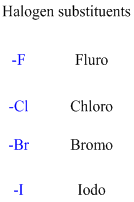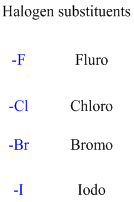
Concept explainers
Interpretation:
The
Concept introduction:
If the compound is having oxygen atom it must be an alcohol
Example is given below
If any halogens are present in the molecule.

If the molecule is having hydroxyl group is called as an alcohol.
For example:

If the molecule is having (
For example:

If the molecule is having (
For example

If the molecule is having (
For example

If the molecule is having (
Example

If the molecule is having (
Example

The given compound is (
Example

(b)
Interpretation:
The functional group should be identified for the given molecule.
Concept introduction:
If the compound is having oxygen atom it must be an alcohol
Example is given below
If any halogens are present in the molecule.

If the molecule is having hydroxyl group is called as an alcohol.
For example:

If the molecule is having (
For example:

If the molecule is having (
For example

If the molecule is having (
For example

If the molecule is having (
Example

If the molecule is having (
Example

The given compound is (
Example

(c)
Interpretation:
The functional group should be identified for the given molecule.
Concept introduction:
If the compound is having oxygen atom it must be an alcohol
Example is given below
If any halogens are present in the molecule.

If the molecule is having hydroxyl group is called as an alcohol.
For example:

If the molecule is having (
For example:

If the molecule is having (
For example

If the molecule is having (
For example

If the molecule is having (
Example

If the molecule is having (
Example

The given compound is (
Example

Want to see the full answer?
Check out a sample textbook solution
Chapter 23 Solutions
Chemistry: Atoms First
- How many electron pairs are shared when a triple bond exists between two carbon atoms? What must he the geometric arrangement around the carbon atoms in a triple bond? Draw the Lewis structure of a simple molecule that contains a triple bond.arrow_forwardEncircle and identify the functional groups of the following molecules.arrow_forwardThe functional group in the following molecule arearrow_forward
- There are 5 different functional groups in the following organic molecules. Name all of themarrow_forwardDraw the different Lewis Diagram of the following molecules by rearranging their carbon chain, hydrogens, or functional group.arrow_forwardCircle all the functional groups in each of these compounds.arrow_forward
- Which two functional groups are in the molecule shown below? Use the terms left and right to distinguish them. Harrow_forwardWhich of the following has(have) the same molecular formula as hexane?arrow_forwardCircle and name the functional groups found in the following organic compounds.arrow_forward
- For the following molecule, give, according to IUPAC standards, it's name. Follow the rules for commas, spaces and dashes.arrow_forwardIdentify and name the functional groups are in the following moleculesarrow_forwardIdentify the functional group in the following molecule. Your choices are alkene, alkyne, aromatic, alcohol, thiol, ether, aldehyde, ketone, carboxylic acid, ester, or amine.arrow_forward
 Living By Chemistry: First Edition TextbookChemistryISBN:9781559539418Author:Angelica StacyPublisher:MAC HIGHER
Living By Chemistry: First Edition TextbookChemistryISBN:9781559539418Author:Angelica StacyPublisher:MAC HIGHER Introductory Chemistry: An Active Learning Approa...ChemistryISBN:9781305079250Author:Mark S. Cracolice, Ed PetersPublisher:Cengage LearningChemistry: Matter and ChangeChemistryISBN:9780078746376Author:Dinah Zike, Laurel Dingrando, Nicholas Hainen, Cheryl WistromPublisher:Glencoe/McGraw-Hill School Pub Co
Introductory Chemistry: An Active Learning Approa...ChemistryISBN:9781305079250Author:Mark S. Cracolice, Ed PetersPublisher:Cengage LearningChemistry: Matter and ChangeChemistryISBN:9780078746376Author:Dinah Zike, Laurel Dingrando, Nicholas Hainen, Cheryl WistromPublisher:Glencoe/McGraw-Hill School Pub Co Introductory Chemistry: A FoundationChemistryISBN:9781337399425Author:Steven S. Zumdahl, Donald J. DeCostePublisher:Cengage Learning
Introductory Chemistry: A FoundationChemistryISBN:9781337399425Author:Steven S. Zumdahl, Donald J. DeCostePublisher:Cengage Learning



